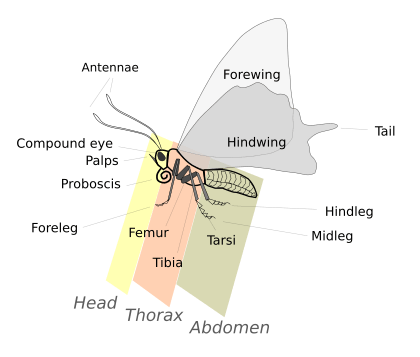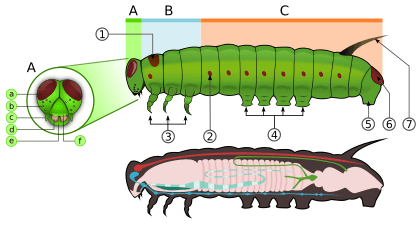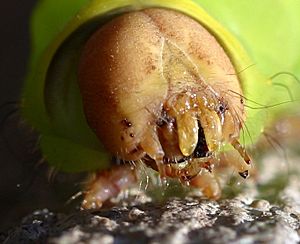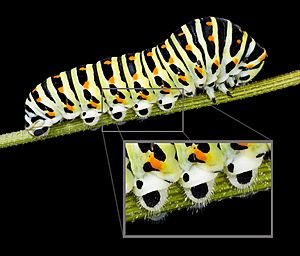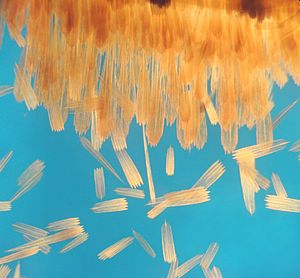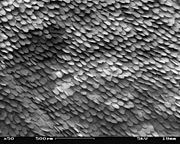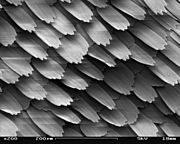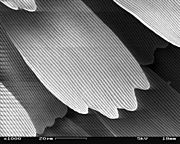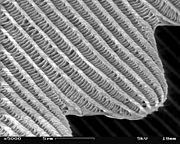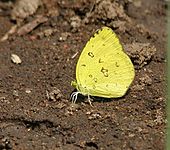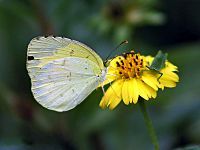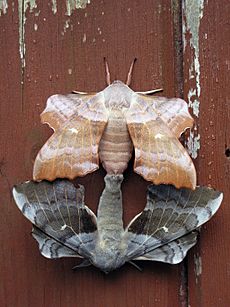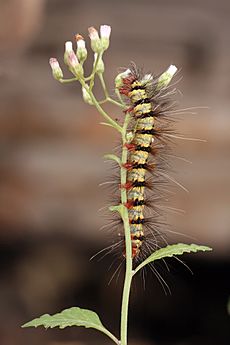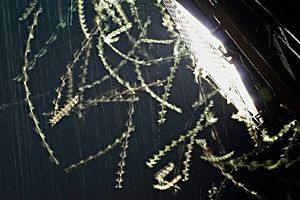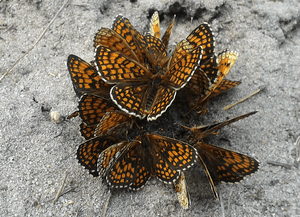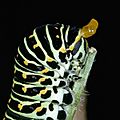Lepidoptera facts for kids
Quick facts for kids Moths and butterflies |
|
|---|---|
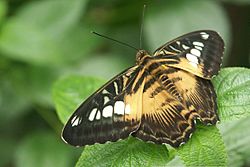 |
|
| The Clipper, Parthenos sylvia (Papilionoidea: Nymphalidae: Limenitidinae) |
|
| Scientific classification | |
| Kingdom: | |
| Phylum: | |
| Class: | |
| Subclass: | |
| Infraclass: | |
| Superorder: | |
| Order: |
Lepidoptera
|
| Suborders | |
|
|
The order Lepidoptera is a huge group of insects. It includes all the butterflies, moths, and skippers. There isn't one common name for all of them together. Most people just say "butterflies and moths." Someone who studies or collects these insects is called a Lepidopterist.
This amazing group has over 180,000 different species. They are found in 128 families and 47 superfamilies. This means they make up 10% of all known living species on Earth! Only the beetles (order Coleoptera) have more species than Lepidoptera.
The name "Lepidoptera" comes from ancient Greek words. "Lepidos" means "scale," and "pteron" means "wing." This name perfectly describes these insects because their wings are covered in tiny scales.
Contents
What Do Moths and Butterflies Look Like?
Moths and butterflies are special because they have tiny scales on their bodies. These scales are especially noticeable on their wings. These insects come in all sizes. Some are tiny, only a few millimeters long. Others are huge, like the Queen Alexandra's birdwing or Atlas moth, with wingspans over 25 centimeters (10 inches)!
Lepidopterans go through a four-stage life cycle. This is called complete metamorphosis. The stages are: egg, larva (or caterpillar), pupa (or chrysalis), and finally, the adult insect. Their bodies are designed in many ways to help them live in different places.
The Head: Sensing and Eating
The head of a moth or butterfly holds many important parts. These include their sensing organs and mouthparts. Adult insects have two compound eyes. Their antennae come in many shapes. Butterfly antennae are usually thin with clubs at the end. Skipper antennae are hooked. Moth antennae can be feathery or branched.
Adult moths and butterflies have a long, tube-like tongue called a proboscis. They usually keep it coiled up under their head. They use it to suck up nectar from flowers or other liquids. Some very old types of moths still have chewing mouthparts, like their ancestors.
Caterpillars, the larval stage, have a tough head. They do not have a proboscis. Instead, they have strong chewing mouthparts called mandibles. They use these to munch on plants. Caterpillars also have small, simple eyes. Some caterpillars have a special organ called a spinneret that makes silk.
The Thorax: Legs and Wings
The thorax is the middle part of the body. It has three fused sections, and each section has a pair of legs. So, adult moths and butterflies have three pairs of legs. In some butterflies, like the Nymphalidae family, the front legs are very small. They don't use them for walking. Their legs are covered in scales. They also have organs on their feet that help them "taste" or "smell" their food!
The two pairs of wings are attached to the middle and back sections of the thorax. The wings are covered in tiny scales. These scales create all the amazing colors and patterns we see. The middle section of the thorax has strong muscles. These muscles help the moth or butterfly fly through the air. Some moths even have special wings that act like ears to help them hear!
Caterpillars have a soft, long body. They usually have three pairs of true legs on their thorax. They also have extra "prolegs" on their abdomen. These prolegs have tiny hooks that help them grip surfaces.
The Abdomen: Body and Movement
The abdomen is the last part of the body. It has 10 segments that can move. The last few segments form the insect's reproductive organs. The genitalia (sex organs) of moths and butterflies are very different between species. This often helps scientists tell different species apart.
Caterpillars usually have four pairs of prolegs on their abdomen. They also have a separate pair of prolegs near their rear end. These prolegs have tiny hooks called crotchets. They help the caterpillar grip and walk. Some caterpillars that live in sand or bore into plants might not have these prolegs.
Amazing Scales on Wings
The wings, head, and parts of the body of moths and butterflies are covered with tiny scales. This is why they are called "Lepidoptera" (scale-winged). Most scales are flat and blade-like. Some are hair-like or have special uses.
The surface of these scales has a complex structure. This structure gives them their color. Some colors come from pigments inside the scales. Other colors are made by the way light bounces off the scale's structure. This is called structural coloration. It can create shiny or iridescent colors.
Scales help keep the insect warm. They also help them glide when flying. Some male moths have special scales that release pheromones (scents) to attract females. But the most important job of scales is to create the beautiful patterns and colors. These patterns help the insects camouflage themselves or mimic other animals. They also act as signals to other moths and butterflies, like for finding a mate.
How Moths and Butterflies Work Inside
Digestive System
Moths and butterflies mostly drink liquids. So, their digestive system is made for sucking. They have a special pump in their throat to help them suck up food. Their gut is usually short and straight.
Circulatory System
Moths and butterflies have insect blood called hemolymph. This blood helps move heat around their body. This is important for keeping warm enough to fly. Their blood is pumped through the veins in their wings by a special organ.
Respiratory System
Moths and butterflies breathe through small holes called spiracles. These are along the sides of their body. Air goes into tubes called trachea. These tubes carry oxygen to all parts of their body.
Different Looks in One Species
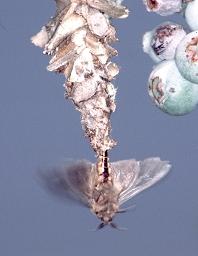
Sometimes, a single species of moth or butterfly can have different looks. This is called polymorphism. These differences can be in color or other features.
- Between sexes: Males and females of the same species can look very different. This is called sexual dimorphism. For example, some female bagworm moths don't have wings, while the males do.
- Between places: Butterflies and moths in different areas might look different. This is geographical polymorphism. The Apollo butterfly has over 600 different forms! This is because they live in small, isolated groups.
- Between seasons: Some species look different depending on the season. This is seasonal polymorphism. The common grass yellow butterfly, for instance, has a darker form in summer and a paler form in winter.
Polymorphism can also involve mimicry. This is when one species looks like another, often to protect itself. Some butterflies have different forms that mimic other species.
Reproduction and Life Cycle
Moths and butterflies go through "complete metamorphosis." This means their life cycle has four main stages. These stages are: egg, larva (caterpillar), pupa, and then the adult insect. Moth pupae are often inside silk cocoons. Butterfly pupae are called chrysalides.
The Butterfly and Moth Life Cycle
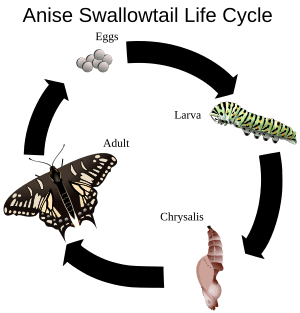
Eggs
Most moths and butterflies lay eggs. They usually lay their eggs on or near the plants their larvae will eat. Females choose the right plant by smelling it. The number of eggs laid can be from a few to thousands!
The eggs are covered by a hard shell called the chorion. It has a thin wax layer to stop the egg from drying out. Eggs also have tiny holes called micropyles. These let sperm enter to fertilize the egg. Eggs vary in size but are always round or oval.
The egg stage usually lasts a few weeks. But eggs laid before winter might wait until spring to hatch. This is called diapause.
Larvae (Caterpillars)
Caterpillars are the first stage after hatching from an egg. They have a tough head and a soft, segmented body. They have chewing mouthparts (mandibles). Most caterpillars are herbivores, meaning they eat plants. They can eat almost any part of a plant. Some are even pests to crops or clothes!
A few caterpillars are carnivores. Some eat ants or other caterpillars. There are even some aquatic caterpillars that live in water.
Caterpillars grow very fast. They shed their skin several times as they grow. Each time they shed, they enter a new "instar." This stage is all about eating and growing. Some caterpillars can take up to three years to develop.
Caterpillars use clever ways to avoid predators. Some can puff up their heads to look like snakes. Many have fake eye-spots to scare away birds. Some caterpillars can even store toxins from the plants they eat. These toxins make them taste bad to predators. They often show bright warning colors (red, orange, black, white) to say "Don't eat me!" This "arms race" between plants and insects has led to them evolving together.
Pupa
After growing through several instars, the caterpillar changes into a pupa. The pupa is a resting stage. Depending on the species, the pupa might be covered in a silk cocoon. It might be buried in the ground. Or it might just hang uncovered, like a butterfly chrysalis.
Inside the pupa, the caterpillar's body changes completely. The adult insect's parts, like wings and antennae, are forming inside. Some pupae can move a little bit. This might help them escape the sun or scare away predators. For example, the pupa of the Mexican jumping bean moth can make the bean jump!
The time spent as a pupa varies a lot. A monarch butterfly might be in its chrysalis for two weeks. Other species might stay in diapause for over 10 months. When the adult is ready, it breaks free from the pupa.
Adult
Most adult moths and butterflies don't live very long. They usually only have a few days to find a mate and lay eggs. Some can live longer, for several weeks. Others might go into diapause and survive the winter, like monarch butterflies.
Most moths and butterflies live on land. But some species, especially certain moths, live in water during their egg, larval, and pupal stages.
How Moths and Butterflies Behave
Flight
Flying is super important for moths and butterflies. It helps them escape predators, find food, and find mates. Their front and back wings are connected and flap together. The front wings do most of the work.
Moths and butterflies need to be warm to fly, about 25-26°C (77-79°F). They can't make their own heat. So, they depend on the environment. Butterflies in cool places will bask in the sun. They spread their wings to soak up the warmth. In hot places, they might fly only in the cooler parts of the day. Some large moths can vibrate their wings to warm up their bodies.
Some butterflies can fly very fast. The southern dart can go as fast as 48.4 km/h (30 mph)! Some hawk moths can fly over 50 km/h (30 mph). Some species can also glide. Hovering is important for hawk moths when they feed on nectar from flowers.
Navigation is key for moths and butterflies, especially those that migrate. Butterflies use the sun to find their way. They can even see polarized light, which helps them navigate on cloudy days. They might also use landmarks like coastlines or mountains.
Moths also navigate. Some studies suggest they might use the Earth's magnetic field. The silver Y moth can even correct its course when winds change.
You might have seen moths circling artificial lights. This is because they use a method called "transverse orientation" to navigate. They try to keep a constant angle to a distant light source, like the Moon. This helps them fly in a straight line. But when they see a close artificial light, the angle changes quickly. This makes them spiral closer and closer to the light.
Migration
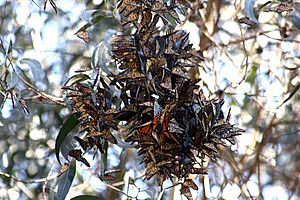
Many moths and butterflies migrate to escape bad weather, like dry seasons. Most migratory species are butterflies. The distance they travel varies. Famous migrants include the monarch butterfly, which flies 4,000-4,800 km (2,500-3,000 miles) from Mexico to Canada! The painted lady butterfly also migrates long distances. Large migrations are also seen in India during the monsoons.
Moths also migrate. The Urania fulgens moth has huge migrations in Central and South America. These can last for five months!
Communication
Moths and butterflies use different ways to communicate.
- Pheromones (scents): These are special chemicals used for mating. Females often release pheromones to attract males. Males detect these scents with their antennae.
- Sounds: Some moths make sounds by rubbing body parts together. This is called stridulation. They use sounds for courtship or to attract mates. They "hear" with special membranes in their abdomens. Some moths make sounds that humans can't hear.
- Touch: Moths can also communicate by vibrating surfaces like leaves.
- Visuals: Butterflies often use their bright colors for communication. Female cabbage butterflies use ultraviolet light. When they fly, their wings flash UV light. Males see these flashes as a signal for a potential mate.
Images for kids
-
A day-flying hummingbird hawk-moth drinking nectar from a species of Dianthus
-
Tobacco hornworm caterpillar (Manduca sexta) parasitized by Braconidae wasp larvae
-
Lepidoptera collection in Cherni Osam Natural Sciences Museum, Troyan, Bulgaria
-
1887 engraving of Prodryas persephone, a fossil lepidopteran from the Eocene.
-
Death's-head hawkmoth (Acherontia lachesis), an old bleached specimen still showing the classical skull pattern on the thorax
See also
 In Spanish: Lepidópteros para niños
In Spanish: Lepidópteros para niños


